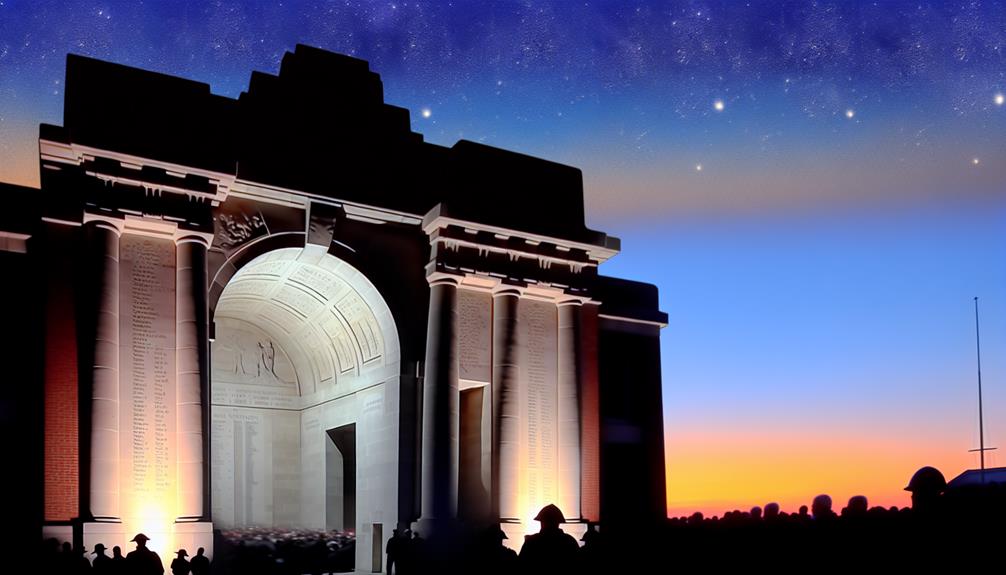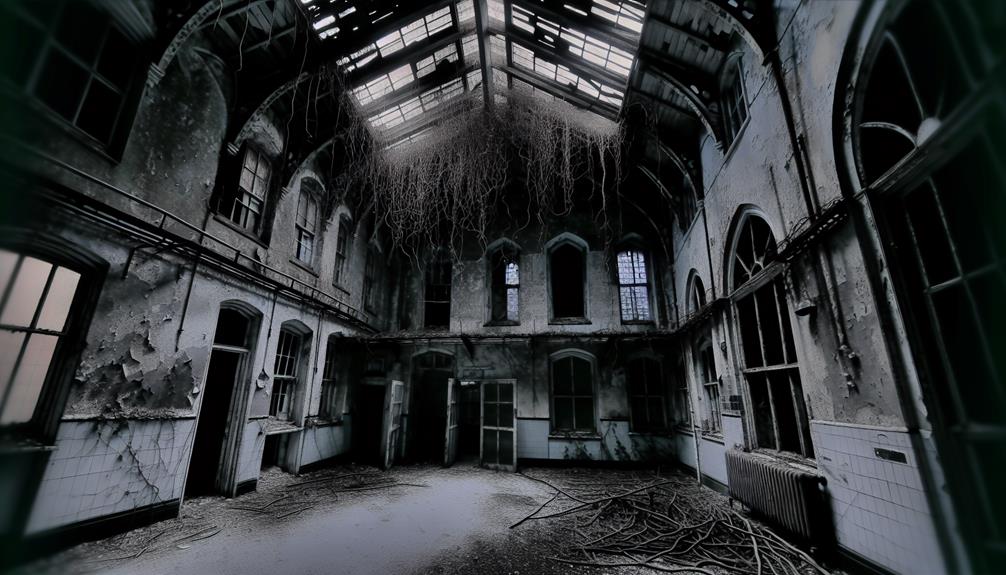The Menin Gate Memorial Tribute stands as a poignant reminder of the sacrifices made by the brave soldiers who fought in World War I. Its inscribed names and ceremonial tributes evoke a sense of solemnity and respect. However, beyond its physical presence, the memorial holds deeper stories waiting to be revealed. As we explore the history, symbolism, and impact of this remarkable structure, we begin to grasp the profound significance it holds for both past and present generations.
Key Takeaways
- Last Post Ceremony symbolizes final farewell to fallen soldiers.
- Menin Gate Memorial commemorates over 54,000 soldiers with no known graves.
- Local community actively involved in honoring war heroes.
- Educational programs and global recognition highlight historical significance.
- Ongoing preservation efforts ensure the memorial's integrity and connection to the past.
History of the Menin Gate Memorial
How did the Menin Gate Memorial come to be established as a significant historical landmark commemorating the sacrifices of soldiers in World War I?
The Menin Gate Memorial, located in Ypres, Belgium, holds immense historical significance. Constructed between 1921 and 1927, the memorial was designed by Sir Reginald Blomfield and commemorates the soldiers of the British and Commonwealth nations who lost their lives in the Ypres Salient during World War I and have no known graves. The Menin Gate is inscribed with the names of over 54,000 soldiers who perished in the Ypres Salient but whose bodies were never recovered.
The architectural significance of the Menin Gate Memorial lies in its imposing form and the intricate detailing that adorns its structure. The memorial's design combines elements of classical architecture with a solemn grandeur that befits its purpose. The sweeping archway of the Menin Gate is a tribute to the sacrifices made by the soldiers it honors, while the meticulous inscriptions serve as a poignant reminder of the scale of loss experienced during the war.
Within the historical context of World War I, the Menin Gate Memorial stands as a symbol of remembrance and tribute to those who gave their lives in the defense of freedom. Its enduring presence serves as a solemn reminder of the human cost of war and the importance of honoring those who made the ultimate sacrifice.
Architectural Design and Symbolism
Exemplifying a harmonious blend of classical architectural elements and profound symbolism, the Menin Gate Memorial in Ypres, Belgium, stands as a poignant demonstration to the valor and sacrifice of soldiers who perished in the Ypres Salient during World War I. The architectural design and symbolism of the Menin Gate Memorial hold significant historical and cultural importance:
- Architectural Symbolism: The Menin Gate's design incorporates symbolic elements such as the Latin cross, representing sacrifice, and the Hall of Memory, symbolizing commemoration and remembrance.
- Cultural Heritage: The memorial's architectural symbolism reflects the cultural heritage of the fallen soldiers and serves as a tribute to their national identities and shared sacrifice.
- Design Aesthetics: The grand arch of the Menin Gate, designed by Sir Reginald Blomfield, showcases neoclassical aesthetics with its imposing columns and intricate detailing, evoking a sense of solemn grandeur.
- Historical Context: Built between 1921 and 1927, the memorial's design and construction occurred in the aftermath of World War I, a period marked by widespread devastation and the need for collective mourning.
- Symbolic Passages: Inscribed with the names of over 54,000 soldiers with no known graves, the Menin Gate's design includes symbolic passages that emphasize the eternal memory of the fallen and the enduring impact of war on society.
Significance of the Last Post Ceremony
The significance of the Last Post Ceremony at the Menin Gate Memorial in Ypres, Belgium, underscores the enduring tribute paid to the fallen soldiers of World War I. This emotional tribute and military tradition have been held every evening since 1928, with the exception of the years during World War II when Ypres was occupied. The ceremony serves as a poignant reminder of the ultimate sacrifice made by those who fought in the Great War.
The Last Post Ceremony table below illustrates the symbolic elements of this solemn event:
| Symbol | Meaning | Significance |
|---|---|---|
| Last Post Bugle Call | A signal for the end of the day in the military | Marks the final farewell to the fallen soldiers |
| Poppy Wreath | Symbol of remembrance | Honors the memory of the soldiers who perished |
| Silence | Moment of reflection and respect | Allows attendees to pay their respects in silence |
The emotional tribute paid during the Last Post Ceremony resonates deeply with visitors, fostering a sense of connection to the past and a shared respect for those who gave their lives in service. This military tradition not only honors the fallen but also serves as a reminder of the enduring impact of war on individuals and communities.
Commemorating the Unknown Soldiers
Among the many ways in which the Menin Gate Memorial in Ypres, Belgium pays homage to the sacrifices of World War I, the act of commemorating the Unknown Soldiers stands as a symbol of collective remembrance and reverence. This solemn tribute to those unidentified individuals who gave their lives in service carries significant emotional weight and historical importance.
Commemorating the Unknown Soldiers at the Menin Gate Memorial involves several key elements:
- The Tomb of the Unknown Warrior: Positioned at the heart of the memorial, the Tomb represents all unidentified soldiers who perished in the war.
- Inscription of Names: The Menin Gate bears the names of over 54,000 soldiers who have no known grave, ensuring they are forever remembered.
- Eternal Flame: Symbolizing eternal remembrance, the flickering flame honors the memory of the fallen, including the Unknown Soldiers.
- Laying of Wreaths: Dignitaries and visitors often lay wreaths at the memorial as a gesture of respect and gratitude.
- Moment of Silence: Regular ceremonies include moments of silence to reflect on the sacrifices made by all soldiers, known and unknown.
Through these acts of commemoration, the Menin Gate Memorial serves as a poignant reminder of the profound impact of war and the importance of honoring all those who have made the ultimate sacrifice.
Impact on Local Community
Having witnessed decades of remembrance and reflection, the Menin Gate Memorial in Ypres, Belgium, has left a profound impact on the local community. The memorial, with its solemn architecture and the names of over 54,000 soldiers who perished in World War I, serves as a constant reminder of the sacrifices made by those who fought for freedom. The local community in Ypres has been deeply involved in honoring and upholding the memory of these fallen heroes.
One significant way the local community shows its support is through various initiatives aimed at preserving the memory of the soldiers and ensuring that their sacrifices are never forgotten. These initiatives include community support programs that provide assistance to veterans and their families, educational programs for younger generations to learn about the history and importance of the memorial, and preservation efforts to maintain the Menin Gate Memorial for future visitors.
To better understand the impact of these initiatives, let's take a closer look at the table below, showcasing some of the local community's key contributions to honoring the fallen soldiers:
| Community Support Initiatives | Local Preservation Efforts |
|---|---|
| Veterans Assistance Programs | Maintenance of Memorial Stone Inscriptions |
| Educational Workshops | Restoration Projects for Memorial Surroundings |
| Memorial Ceremonies | Outreach Programs for Youth Engagement |
| Fundraising Events | Research and Documentation Projects |
| Volunteer Opportunities | Commemorative Art Installations |
Visitors' Reflections and Experiences
Upon visiting the Menin Gate Memorial in Ypres, Belgium, visitors often find themselves immersed in a poignant atmosphere that invites deep reflection and personal contemplation. The experience of standing amidst the towering memorial, engraved with the names of over 54,000 soldiers who have no known graves, evokes a range of personal reflections and emotional impact.
Here are some common themes that emerge from visitors' reflections and experiences:
- Sense of Loss: Many visitors express a profound sense of loss as they contemplate the sheer number of lives sacrificed during World War I, leading to introspection about the futility of war.
- Gratitude and Remembrance: Visitors often feel compelled to pay their respects, offering gratitude to the fallen soldiers and ensuring that their memory endures.
- Connection to History: The memorial serves as a powerful link to history, prompting visitors to reflect on the significance of the events that transpired in this region a century ago.
- Humanity Amidst Tragedy: Amidst the somber atmosphere, visitors often find moments of humanity and compassion, connecting with the individual stories behind the engraved names.
- Renewed Commitment to Peace: The emotional impact of the memorial frequently inspires a renewed commitment to promoting peace and understanding, fostering a sense of unity across cultures and nations.
Visitors' reflections at the Menin Gate Memorial underscore the enduring impact of war on individuals and societies, emphasizing the importance of remembrance and reconciliation.
Restoration and Preservation Efforts
Efforts to restore and preserve the Menin Gate Memorial in Ypres, Belgium, have been meticulously coordinated to guarantee the conservation of this iconic monument for future generations. The preservation techniques employed on the Menin Gate Memorial are a testament to the dedication to conserving its historical significance and cultural heritage. Conservation efforts have included gentle cleaning to remove pollutants and grime without damaging the stonework, as well as repairs to any cracks or damages caused by weathering and age.
The historical significance of the Menin Gate Memorial, as a tribute to the soldiers who lost their lives in World War I and whose final resting places remain unknown, underscores the importance of these preservation efforts. It stands not only as a physical structure but as a symbol of remembrance and reverence for the sacrifices made during the war. Preserving the Menin Gate Memorial is essential in maintaining a connection to the past for present and future generations, ensuring that the memory of those who fought and died is not forgotten.
Educational Programs and Initiatives
Educational programs and initiatives aimed at fostering a deeper understanding of the historical context and significance of the Menin Gate Memorial play a crucial role in preserving the memory of the soldiers commemorated at this iconic site. These initiatives not only educate current and future generations about the sacrifices made during World War I but also guarantee that the legacy of those who fought and perished is upheld.
Here are five key components of the educational programs surrounding the Menin Gate Memorial:
- Educational Outreach: Collaborating with schools, universities, and educational institutions to incorporate the memorial's history into their curricula.
- Community Engagement: Involving local communities in understanding the memorial's historical importance and encouraging active participation in related events.
- Interactive Workshops: Conducting workshops that allow participants to engage with artifacts, stories, and historical accounts related to the memorial.
- Cultural Exchanges: Facilitating cultural exchange programs that bring together individuals from different backgrounds to learn about the shared history of the Menin Gate Memorial.
- Historical Lectures: Organizing lectures by historians and experts to explore further into the historical context of World War I and the significance of the Menin Gate Memorial in honoring the fallen soldiers.
Global Recognition and Remembrance
Globally acknowledged for its historical significance and solemn commemoration, the Menin Gate Memorial stands as a poignant symbol of remembrance for the fallen soldiers of World War I. This iconic structure in Ypres, Belgium, serves as a focal point for global solidarity, where people from all corners of the world gather to pay tribute to the sacrifices made during the Great War. The Menin Gate's role in fostering international remembrance transcends borders, emphasizing the universal value of honoring those who gave their lives in service to their countries.
As a demonstration of cultural heritage, the Menin Gate Memorial encapsulates the spirit of tribute, uniting individuals in a shared moment of reflection and gratitude for the bravery and selflessness of the fallen soldiers. Its architectural grandeur and the solemnity of the Last Post ceremony further elevate its status as a symbol of collective memory and reverence. The Menin Gate's ability to draw visitors from diverse backgrounds underscores its significance as a place where remembrance knows no boundaries and where the legacy of those who perished in World War I continues to resonate globally.
In commemorating the past, the Menin Gate Memorial reinforces the importance of preserving history and upholding the values of peace and unity that transcend time and place. This enduring symbol of remembrance serves as a poignant reminder of the cost of war and the collective responsibility to honor and remember those who made the ultimate sacrifice for a better future.
Future of the Menin Gate Memorial
In considering the future of the Menin Gate Memorial, strategic preservation efforts must be implemented to safeguard its historical significance for generations to come. The sustainable development and technology integration of the memorial will play vital roles in guaranteeing its longevity and relevance in the modern era.
- Preservation Techniques: Implementing advanced preservation techniques will help maintain the structural integrity of the Menin Gate Memorial, protecting it from environmental degradation and wear over time.
- Educational Programs: Developing educational programs that utilize technology integration, such as virtual tours and interactive displays, can enhance visitors' understanding of the memorial's significance and history.
- Community Engagement: Encouraging community engagement through sustainable initiatives like volunteer programs and fundraising events can foster a sense of ownership and pride in the preservation of the memorial.
- Research and Innovation: Investing in research and innovation to discover new sustainable materials and technologies for conservation efforts will ensure the Menin Gate Memorial remains a symbol of remembrance for future generations.
- Collaboration with Experts: Collaborating with experts in preservation, sustainable development, and technology integration will provide valuable insights and best practices to guide the long-term conservation strategy of the memorial.
Frequently Asked Questions
How Were the Names for the Menin Gate Memorial Chosen?
The names for the Menin Gate Memorial were chosen through a meticulous selection process that aimed to honor soldiers who fought in World War I.
The historical significance of these names lies in the representation of the soldiers who made the ultimate sacrifice. Each name etched on the memorial symbolizes a life lost in the service of their country, ensuring that their memory is preserved for future generations to remember and honor.
Are There Any Hidden Symbols in the Architectural Design?
While the Menin Gate Memorial may seem straightforward in its design, closer inspection reveals a wealth of hidden symbols and architectural secrets. From the intricate carvings representing different regiments to the strategic placement of certain elements, every aspect of the memorial holds deeper meaning.
These symbolic elements serve to honor and remember the fallen soldiers in a profound and meaningful way, adding layers of significance to the structure's design.
What Happens to the Wreaths After the Last Post Ceremony?
After the last post ceremony at the Menin Gate Memorial, the wreaths are carefully preserved to honor the memory of the fallen soldiers.
These wreaths are respectfully disposed of by recycling the flowers and composting any organic materials.
Some wreaths may be reused in future ceremonies or events to continue paying homage to the sacrifices made by those who served.
This practice guarantees a sustainable and meaningful way to remember and honor the fallen.
How Are the Unknown Soldiers Identified for Commemoration?
The identification process for unknown soldiers involves meticulous research utilizing historical records, such as military archives, personal effects, and forensic analysis. Through these methods, specialists aim to uncover clues that may lead to the recognition of the fallen individuals.
How Has the Memorial Influenced Local Art and Culture?
The Menin Gate Memorial has greatly influenced local art and culture through its profound impact on the community. Local artwork often reflects the themes of remembrance, sacrifice, and unity that are central to the memorial.
The memorial has become a symbol of collective memory and has inspired various artistic expressions that serve to honor the fallen soldiers and preserve their legacy within the community. This cultural influence continues to shape the artistic landscape of the region.
Conclusion
To sum up, the Menin Gate Memorial stands as a timeless tribute to the valor and sacrifice of those who fought in World War I.
Like a sentinel of remembrance, its neoclassical architecture and inscribed names serve as a poignant reminder of the price of war.
Through ongoing preservation efforts and educational programs, the memorial continues to honor the fallen and perpetuate their legacy for future generations.


